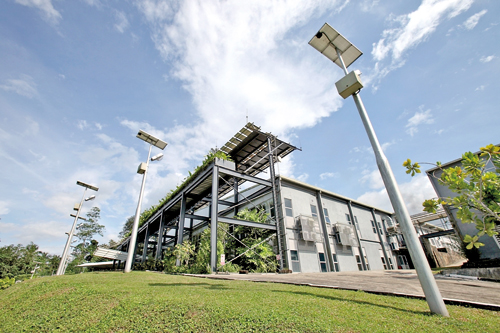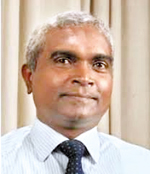Yet another Committee to solve power crisis!

File picture of solar power at a local factory site.
Isn’t it hilarious? We have another cabinet sub-committee to solve the power crisis. The Cabinet press briefing of April 9, 2019 says so.
Actually, the crisis was created by a similar sub-committee. That committee was called the “Cabinet Committee on Economic Management (CCEM)”. That committee has now been abolished; at least in theory. So now, the cabinet has another committee. Tragically, the same person, namely the Prime Minister, presides over all these “committees”.
Look at the widely-known record of power plant cancellations and manipulations by the committees, presided over by the Prime Minister:
March 31, 2002: Prime Minister cancelled Norochcholai power plant, and then ordered as much as 300 Megawatt of diesel power plants that sent electricity costs spiralling upward. As a result, throughout the last decade, Sri Lanka became the only country in the world (except tiny islands) to produce 65 per cent of electricity from oil. The same Prime Minister chased the Japanese Ambassador away, stating Japan’s funds and technology are not required: (A subsequent government allowed CEB to build the power plant, but with Chinese technology bought at a Japanese price, and the rest is history).
Mid-2003:The Prime Minister cancelled the Upper Kotmale 150 Megawatt hydropower plant, the day before the ceremony to lay the foundation stone was arranged by the then Minister of Power, who was his Deputy. Days later, he ordered more diesel power plants: (A subsequent government allowed CEB to build the Upper Kotmale power plant, too, now operational).

Dr.Tilak Siyambalapitiya.
Mid-2015: The Cabinet sub-committee chaired by the Prime Minister objected to and later cancelled two power plants in Trincomalee, each 500 Megawatt. Cancelled them on May 15, 2016, a Sunday. One power plant was to go for competitive bidding one day later, on Monday May 16, 2016; ordered more diesel power plants, with a label “LNG” power plant. Sri Lanka has no LNG. Indian PM Narendra Modi, whose Government entity NTPC was in partnership with CEB for one Trincomalee power plant so cancelled, laughed all the way to Delhi, when our Prime Minister’s “committee” asked him to “convert” the Sampur power plant to gas. Power plants cannot be “converted” from coal to gas; ask any power generation engineer if you do not know.
Mid-2016 to date: For four years, the same “committee” sits entertaining proposals for gas (LNG) terminals (note the emphasis on the plural, terminals), whereas Sri Lanka needs only one LNG terminal. The law says competitive bidding is a must, but the Committee undermines the procurement policies. No terminal in sight as yet, with the President and Prime Minister each bringing their own favourite company’s proposals and counter proposals for the LNG terminal. So for four years, Sri Lanka has enjoyed a “battle of the gas terminals” or a “terminal fight”, between the two highest politicians of the country.
Mid-2016, Committee within a committee: A Committee headed by an economist was appointed, to rubber stamp the “committee’ decision to kill the two Trincomalee power plants. The power plants which were to be ready in 2020 and 2022 would have just missed the crisis but the present crisis would have been short-lived. Power system stability and lowest fuel bills Sri Lanka had in 2015 would have been restored by 2020. In the disgusting political culture, the two highest politicians of the land could have taken credit to say, “We solved the power crisis” and offered a price reduction on the eve of 2020 elections.
As we have said repeatedly in these columns and elsewhere, the country is persistently short of solid, baseload generating capacity. Absence of wind, solar, biomass, or similar power plants is not the reason for this shortage; neither would they be the solution. They can supplement, but they cannot substitute the crying need for solid baseload, lower cost electricity generating capacity.
Sri Lanka has hundreds of qualified engineers; however politicians, businessmen pushing wind, solar, biomass, gas and coal, and the man on the street do not know (and need not know) how to build and manage a power system, whereas engineers have been taught and trained for that, using public money, of course.
The new and hilarious committee headed by the Prime Minister will not bring any solution to the problem. The Prime Minister’s committees, in fact, are the problem; they cannot be the solution to the problem created by committees, with the President agreeing and frequently bringing in counter proposals from his favoured contractors.
What do we do now?
Not a single large power plant has entered the construction stage since 2012, since CEB began work on generator number 3 at Norochcholai, the country’s only coal-fired power plant. It is now five years since Norochcholai was completed, and none of the new larger power plants in the long-term plan has reached anywhere near the foundation stage. Do not say, “why Uma Oya”, “why Boradlands”, “how about that wind and this solar”; they are all supplements but not the medicine to cure the disease.
If the Government wants to listen to the professional point of view, here is the solution, step by step. If the Government wants to speak to politicians on how they get power generation projects done, speak to PM Modi, Prime Minister Sheikh Hasina and Chief Minister E.K. Palaniswami of Tamil Nadu, to learn how they lead from the front (not run away), to build gas terminals, and power plants run on coal, gas, nuclear, wind and solar.
Step 1: Appoint a task force with full powers (no politicians, no committees or anyone linked to various committees), to build 1000 Megawatt in Trincomalee, expandable to 2000 MW. Target date to produce electricity: 500 Megawatt in 2023, 500 Megawatt in 2024 (sorry they cannot be built before the upcoming elections, but if solid decisions are taken now, they would be good selling points for 2025 elections).
Step 2: Appoint a task force with full powers (no politicians or anyone linked to any of the committees), to build one LNG terminal (friends of politicians number 1 and 2 in the government please keep away; there will be competitive bidding for the gas terminal and join that). Target date to get gas into the country: 2022. Have all the planned gas-fired power plants (existing and new) ready to run by 2022 on gas. Establish a Gas Authority and a Gas Industry Act, to ensure respectable investors come in; not the dubious contractors presently hovering around various politicians.
Step 3: Get more wind and solar power plants into the grid, on the basis of competitive bidding, fix limits to what can be absorbed into the grid (remember: a solid power generating system, not a shaky one as we have, is required to absorb more small hydro, wind, solar and biomass, to cope with shaky resources like wind and sunshine)
Step 4: With steps 1, 2 and 3 firmly in place and in progress, be truthful, and tell the people, what options are then available to run until 2022; either accept power cuts up to 8 hours or accept higher electricity prices to pump diesel to the politician’s heart’s content. Do not fool the people by saying “electricity prices will not be increased by the government”. People do understand that the government has messed-up the electricity sector. They would not mind a price increase to pump diesel to power plants, provided the correct decisions for the long term, in the correct sequence, are implemented.
Otherwise, perish.
Committees cannot build power plants or gas terminals, or even decide on them, which are extremely delicate technical matters. They are decided by experts on power plant, gas industry and marine/ports, and built by institutions or companies. Not by a “Cabinet sub-committee on this and that”.
However, steps taken now are precisely in the reverse order. No committees were appointed at all to decide on emergency diesel power plants that produce electricity at Rs. 31 per unit or more, and to fool the public that the crisis has gone away.
Emergency diesel gets instant Cabinet approval! If you do not believe me, read the Cabinet decisions on April 9 http://www.cabinetoffice.gov.lk/cab/, where a 100 MW emergency power plant got instant approval (cost: Rs. 31 per unit). At the same meeting, decisions on cheaper power plants (cost: Rs.8 to 14 per unit) were deferred for two weeks and possibly forever, and a “Committee” chaired by the Prime Minister was appointed!!! That guarantees that there will be no decision at all.
That is the government’s way to ensure CEB or the private sector would not be allowed to build cheaper power plants of any sorts! Committees and more committees! And the agony of this nation continues ……. (The writer is an energy specialist and a regular commentator on these issues. He can be reached at tilak@rmaenergy.lk).


